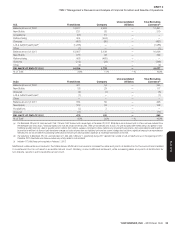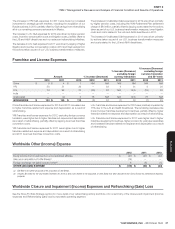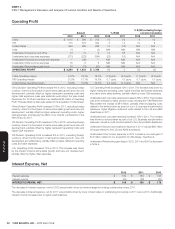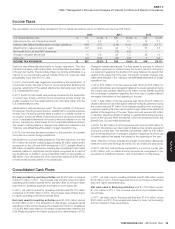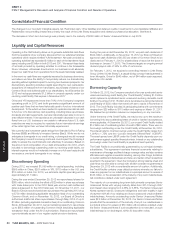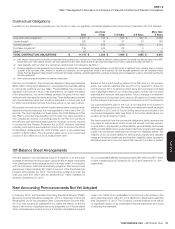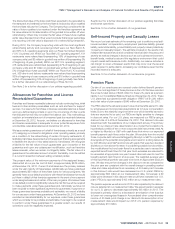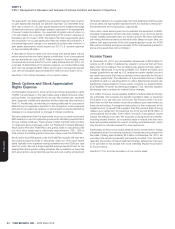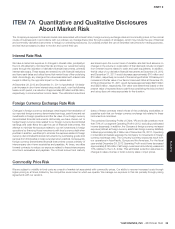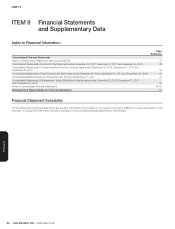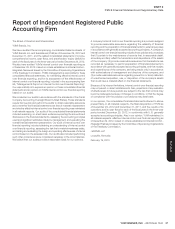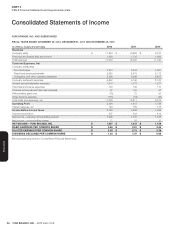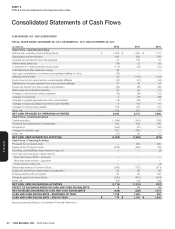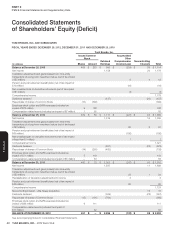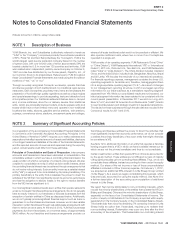Pizza Hut 2012 Annual Report Download - page 125
Download and view the complete annual report
Please find page 125 of the 2012 Pizza Hut annual report below. You can navigate through the pages in the report by either clicking on the pages listed below, or by using the keyword search tool below to find specific information within the annual report.
YUM! BRANDS, INC.-2012 Form10-K 33
Form 10-K
PART II
ITEM7Management’s Discussion and Analysis ofFinancial Condition and Results ofOperations
The discounted value of the future cash fl ows expected to be generated by
the restaurant and retained by the franchisee is reduced by future royalties
the franchisee will pay the Company.The Company thus considers the fair
value of future royalties to be received under the franchise agreement as
fair value retained in its determination of the goodwill to be written off when
refranchising.Others may consider the fair value of these future royalties
as fair value disposed of and thus would conclude that a larger percentage
of a reporting unit’s fair value is disposed of in a refranchising transaction.
During 2012, the Company’s reporting units with the most signifi cant
refranchising activity and recorded goodwill were our Taco Bell U.S.
and KFC U.S. operating segments and our Pizza Hut United Kingdom
(“U.K.”) business unit.Within our Taco Bell U.S. operating segment, 181
restaurants were refranchised (representing 15% of beginning-of-year
company units) and $6million in goodwill was written off (representing 5%
of beginning-of-year goodwill). Within our KFC U.S. operating segment,
218 restaurants were refranchised (representing 47% of beginning-of-year
company units) and $7million in goodwill was written off (representing
5% of beginning-of-year goodwill). Within our Pizza Hut U.K. business
unit, 359 dine-in and delivery restaurants were refranchised (representing
86% of beginning-of-year company units) and $16million in goodwill was
written off (representing 16% of beginning-of-year goodwill).See Note4
for a further discussion of our refranchising of Pizza Hut U.K.
See Note2 for a further discussion of our policies regarding goodwill.
Allowances for Franchise and License
Receivables/Guarantees
Franchise and license receivable balances include continuing fees, initial
fees and other ancillary receivables such as rent and fees for support
services.Our reserve for franchisee or licensee receivable balances is based
upon pre-defi ned aging criteria or upon the occurrence of other events
that indicate that we may not collect the balance due.This methodology
results in an immaterial amount of unreserved past due receivable balances
at December29, 2012.As such, we believe our allowance for franchise
and license receivables is adequate to cover potential exposure from
uncollectible receivable balances at December29, 2012.
We issue certain guarantees on behalf of franchisees primarily as a result
of 1) assigning our interest in obligations under operating leases, primarily
as a condition to the refranchising of certain Company restaurants, 2)
facilitating franchisee development and 3) equipment fi nancing arrangements
to facilitate the launch of new sales layers by franchisees.We recognize
a liability for the fair value of such guarantees upon inception of the
guarantee and upon any subsequent modifi cation, such as franchise
lease renewals, when we remain contingently liable.The fair value of a
guarantee is the estimated amount at which the liability could be settled
in a current transaction between willing unrelated parties.
The present value of the minimum payments of the assigned leases,
discounted at our pre-tax cost of debt, is approximately $675million,
at December29, 2012.Current franchisees are the primary lessees
under the vast majority of these leases.Additionally, we have guaranteed
approximately $54million of franchisee loans for various programs.We
generally have cross-default provisions with these franchisees that would
put them in default of their franchise agreement in the event of non-payment
under assigned leases and certain of the loan programs.We believe these
cross-default provisions signifi cantly reduce the risk that we will be required
to make payments under these guarantees and, historically, we have not
been required to make signifi cant payments for guarantees.If payment on
these guarantees becomes probable and estimable, we record a liability
for our exposure under these guarantees.At December29, 2012 we have
recorded an immaterial liability for our exposure under these guarantees
which we consider to be probable and estimable.If we begin to be required
to perform under these guarantees to a greater extent, our results of
operations could be negatively impacted.
See Note2 for a further discussion of our policies regarding franchise
and license operations.
See Note19 for a further discussion of our guarantees.
Self-Insured Property and Casualty Losses
We record our best estimate of the remaining cost to settle incurred self-
insured workers’ compensation, employment practices liability, general
liability, automobile liability, product liability and property losses (collectively
“property and casualty losses”).The estimate is based on the results of an
independent actuarial study and considers historical claim frequency and
severity as well as changes in factors such as our business environment,
benefi t levels, medical costs and the regulatory environment that could
impact overall self-insurance costs.Additionally, our reserve includes a
risk margin to cover unforeseen events that may occur over the several
years required to settle claims, increasing our confi dence level that the
recorded reserve is adequate.
See Note19 for a further discussion of our insurance programs.
Pension Plans
Certain of our employees are covered under defi ned benefi t pension
plans.The most signifi cant of these plans are in the U.S.We have recorded
the under-funded status of $345million for these U.S. plans as a pension
liability in our Consolidated Balance Sheet as of December29, 2012.These
U.S. plans had a projected benefi t obligation (“PBO”) of $1,290million
and a fair value of plan assets of $945million at December29, 2012.
The PBO refl ects the actuarial present value of all benefi ts earned to date
by employees and incorporates assumptions as to future compensation
levels.Due to the relatively long time frame over which benefi ts earned to
date are expected to be paid, our PBOs are highly sensitive to changes
in discount rates.For our U.S. plans, we measured our PBOs using a
discount rate of 4.40% at December29, 2012.This discount rate was
determined with the assistance of our independent actuary.The primary
basis for our discount rate determination is a model that consists of a
hypothetical portfolio of ten or more corporate debt instruments rated Aa
or higher by Moody’s or S&P with cash fl ows that mirror our expected
benefi t payment cash fl ows under the plan.We exclude from the model
those corporate debt instruments fl agged by Moody’s or S&P for a potential
downgrade (if the potential downgrade would result in a rating below Aa
by both Moody’s and S&P) and bonds with yields that were two standard
deviations or more above the mean.In considering possible bond portfolios,
the model allows the bond cash fl ows for a particular year to exceed the
expected benefi t cash fl ows for that year.Such excesses are assumed to
be reinvested at appropriate one-year forward rates and used to meet the
benefi t payment cash fl ows in a future year.The weighted-average yield
of this hypothetical portfolio was used to arrive at an appropriate discount
rate.We also ensure that changes in the discount rate as compared to
the prior year are consistent with the overall change in prevailing market
rates and make adjustments as necessary.A 50 basis-point increase
in this discount rate would have decreased our U.S. plans’ PBOs by
approximately $93million at our measurement date.Conversely, a 50
basis-point decrease in this discount rate would have increased our U.S.
plans’ PBOs by approximately $105million at our measurement date.
The pension expense we will record in 2013 is also impacted by the discount
rate we selected at our measurement date.We expect pension expense
for our U.S. plans to decrease approximately $8million in 2013.The
decrease is primarily driven by a decrease in amortization of net loss due
to lower net unrecognized losses in Accumulated other comprehensive
income.A 50 basis-point change in our discount rate assumption at our
measurement date would impact our 2013 U.S. pension expense by
approximately $13million.


